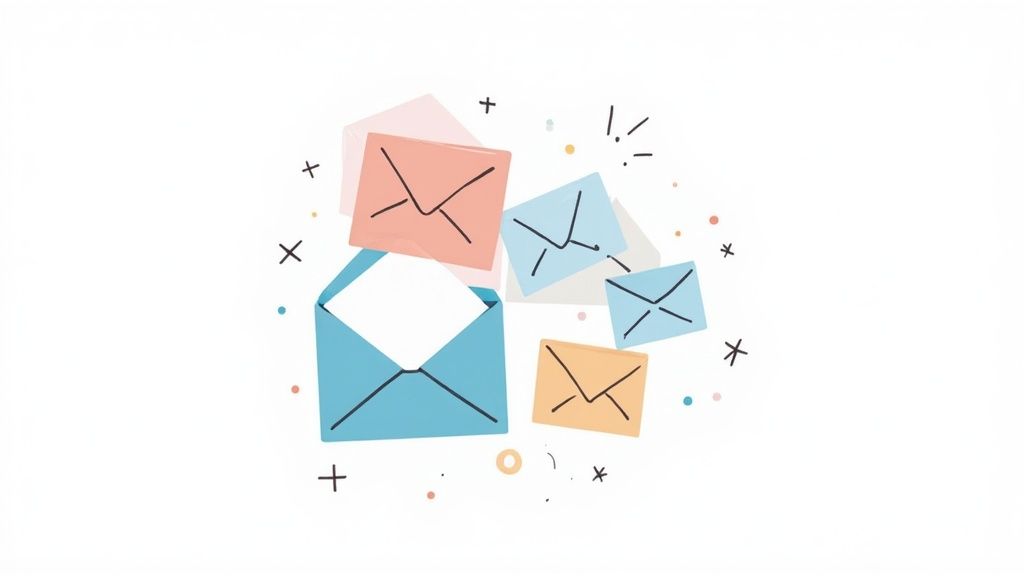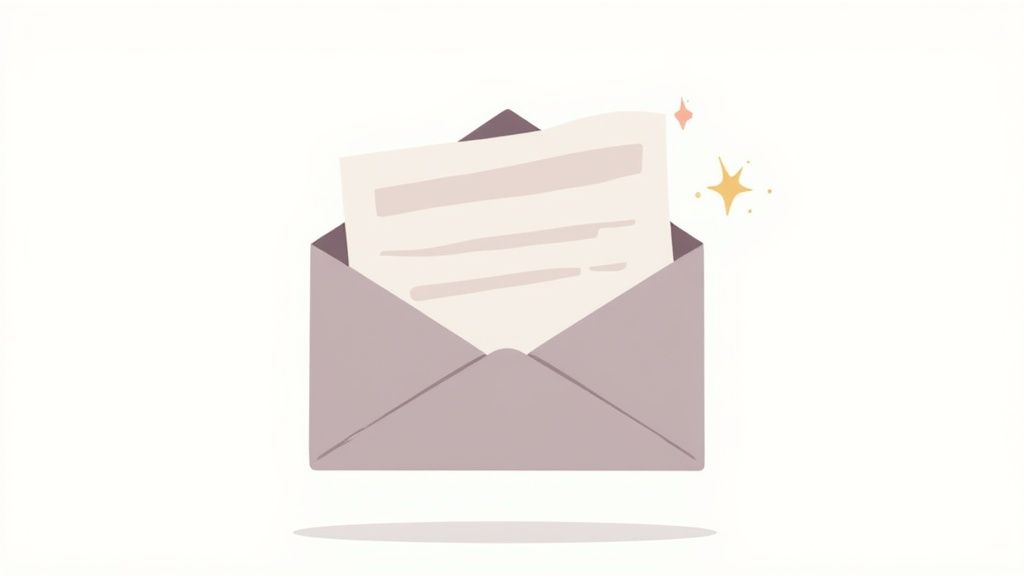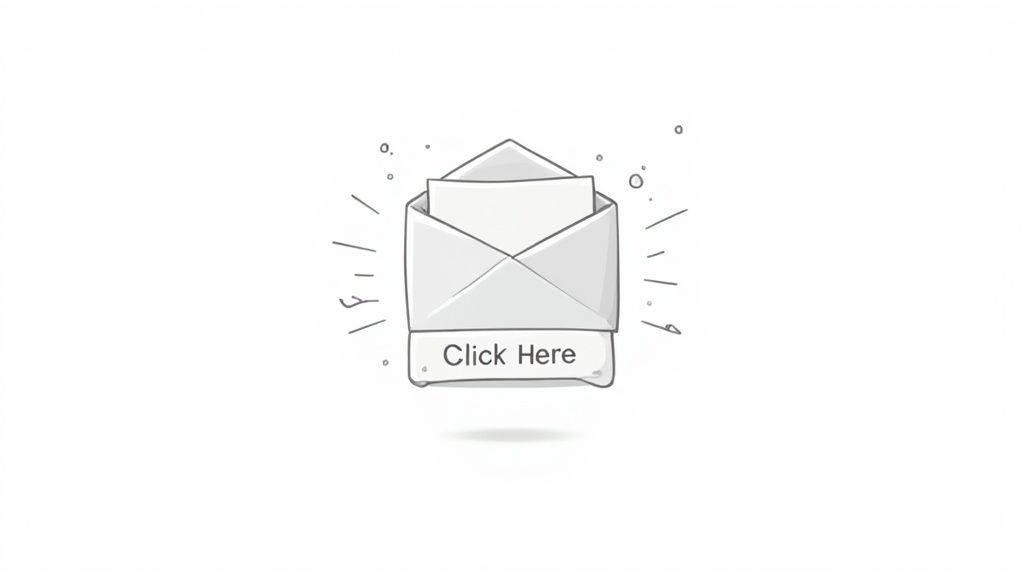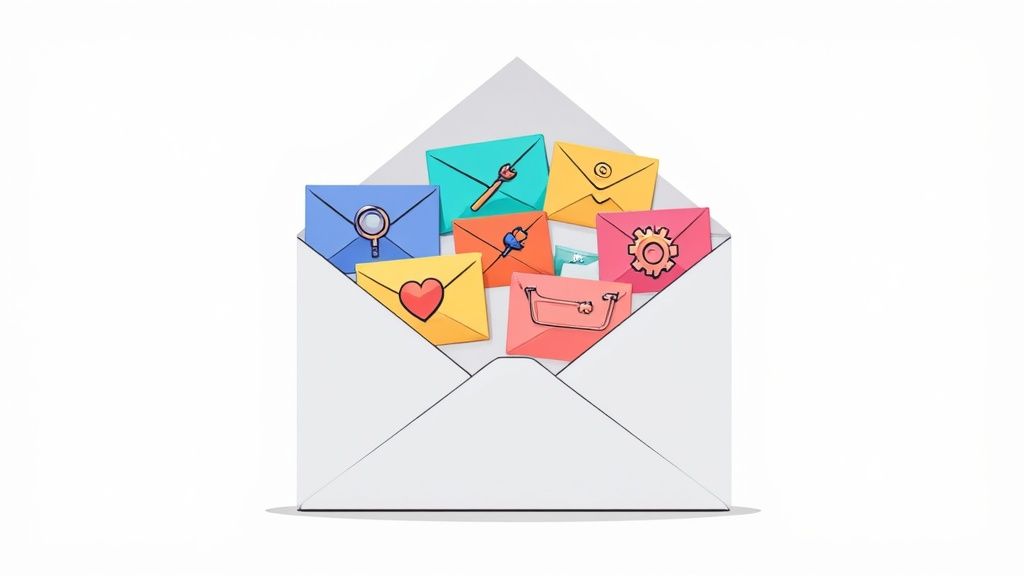Email marketing remains one of the most powerful tools in a digital marketer's arsenal, consistently delivering a high return on investment. Yet, simply sending emails is not a strategy for success. In a world of overflowing inboxes and short attention spans, the difference between an email that gets deleted and one that drives a conversion lies in the details. Success hinges on precision, strategy, and delivering genuine value.
This guide moves beyond generic advice to provide a strategic blueprint of actionable email marketing tips. We will explore sophisticated techniques that can transform your campaign performance. You will learn how to segment your audience for maximum impact, craft subject lines that demand to be opened, and personalize content to make every subscriber feel understood.
We will also cover the critical, behind-the-scenes work, from the technical nuances of deliverability that ensure you reach the inbox to the smart use of automation for building lasting relationships. Whether you're refining an existing strategy or building one from scratch, these insights will help you create emails that not only get opened but also achieve meaningful, measurable results.
1. Segment Your Email List
One of the most powerful email marketing tips is to stop sending generic, one-size-fits-all messages. Email list segmentation is the practice of dividing your subscribers into smaller, more targeted groups based on specific criteria. This allows you to craft highly relevant messages that resonate with each audience, leading to significant improvements in open rates, click-throughs, and conversions.

Think about how major brands use this tactic. Spotify segments users by listening habits to recommend new music, while Amazon suggests products based on your purchase and browsing history. Each message feels personal because it is.
How to Implement Segmentation
You don't need dozens of complex groups to get started. Begin with a few foundational segments and expand as you gather more data. For a deeper dive into tailoring your messages for specific audiences, consider how to master your email segmentation strategy.
Here are a few actionable ways to start segmenting today:
- Geographic Location: Send promotions for local events or region-specific products.
- Engagement Level: Target your most active subscribers with exclusive offers and re-engage inactive ones with a special campaign.
- Purchase History: Group customers based on past purchases to upsell, cross-sell, or suggest complementary items. For example, send accessory recommendations to customers who recently bought a primary product.
2. Craft Compelling Subject Lines
Your subject line is the gatekeeper to your email content. It's the first thing your subscribers see and is often the single factor determining whether they open your message or send it straight to the trash. One of the most critical email marketing tips is to master the art of writing concise, intriguing, and relevant subject lines that demand attention in a crowded inbox.

Think about the subject lines that catch your eye. Grammarly’s personalized "Your writing stats are in, [Name]" creates curiosity, while Netflix’s "Your next binge-watch is here" promises immediate value. These messages work because they are tailored, benefit-driven, and pique interest without giving everything away.
How to Write Subject Lines that Get Opened
The key is to balance clarity with creativity. While crafting compelling subject lines is crucial, there are many other factors at play. For a comprehensive overview, explore these proven tips to improve email open rates.
Here are a few actionable ways to enhance your subject lines today:
- Use Personalization and Curiosity: Incorporate the subscriber's name or reference their past activity to make the email feel personal. Pose a question or create an information gap to spark curiosity.
- Create Urgency or Scarcity: Use phrases like "24 hours left" or "Limited stock" to encourage immediate action. Ensure the urgency is genuine to maintain trust.
- Keep it Short and Mobile-Friendly: A significant portion of emails are opened on mobile devices, which have limited character displays. Aim for 30-50 characters to ensure your full message is visible.
- Leverage Numbers and Action Verbs: Numbers catch the eye and imply a straightforward, data-backed message. Start with strong action verbs to create a sense of momentum and purpose.
3. Optimize for Mobile Devices
Ignoring mobile users is no longer an option in today's email marketing landscape. Mobile optimization ensures your emails look great and function seamlessly on smartphones and tablets. With a majority of emails now opened on mobile devices, failing to design for a smaller screen means you risk alienating a huge portion of your audience and sacrificing engagement.

Brands that excel at this understand that mobile-first is a mindset, not an afterthought. Starbucks, for instance, uses simple, single-column designs with large, unmissable call-to-action buttons. Similarly, Airbnb keeps its mobile emails concise, using minimal text and optimized images that load quickly, ensuring a smooth experience for travelers on the go.
How to Implement Mobile Optimization
A responsive design that automatically adapts to the user's screen size is the foundation of mobile-friendly email. This is one of the most critical email marketing tips for maintaining a professional and user-friendly experience.
Here are a few actionable ways to start optimizing for mobile today:
- Use a Single-Column Layout: This is the easiest way to ensure your content is readable and stacks vertically on any screen without horizontal scrolling.
- Make Buttons Tappable: Ensure CTAs and links are at least 44x44 pixels so they are easy to tap with a thumb.
- Keep Subject Lines Short: Aim for under 30 characters to prevent your subject line from being cut off on mobile notification screens.
- Optimize Images: Compress images to reduce their file size for faster loading on mobile networks, and always use descriptive alt text.
4. Personalize Your Content
Beyond simply using a subscriber's first name, true email personalization involves tailoring the entire message to their individual preferences, behaviors, and history. This advanced approach creates a deeply relevant and engaging experience, making your audience feel understood rather than just marketed to. This is one of the most effective email marketing tips for boosting engagement and driving conversions.

Think of how industry leaders like Amazon and Netflix have mastered this. Amazon's product recommendations are based on your browsing and purchase history, while Netflix suggests new shows based on what you’ve already watched. Each email feels like a one-on-one conversation because the content is uniquely relevant.
How to Implement Personalization
Start with simple personalization and gradually incorporate more sophisticated data points. For those looking to create more authentic and relatable messages, learning how to humanize your marketing content can provide valuable insights.
Here are a few practical ways to begin personalizing your emails:
- Behavioral Triggers: Use data to send relevant automated emails. For example, send a follow-up email with related products after a customer makes a purchase or an abandoned cart reminder if they leave items behind.
- Dynamic Content: Change specific blocks of content within a single email template based on subscriber data. You could show different product recommendations or hero images based on past purchase categories or interests.
- Location-Specific Offers: Promote local store events, region-specific sales, or items that are popular in the subscriber's geographical area.
- Personalized Send Times: Analyze when individual users are most likely to open your emails and schedule sends accordingly using send-time optimization tools.
5. Implement A/B Testing
Guesswork has no place in a high-performing email strategy. One of the most essential email marketing tips is to adopt A/B testing, also known as split testing. This practice involves sending two variations of a single campaign to two small, similar subsets of your audience. By measuring which version drives more opens, clicks, or conversions, you can send the winning email to the rest of your list, ensuring maximum impact.
This data-driven approach removes subjectivity and lets your audience’s behavior guide your decisions. The famous 2012 Obama campaign, for example, reportedly raised an additional $60 million by A/B testing different subject lines and call-to-action buttons to find the most effective combinations. This shows how small tweaks can yield monumental results.
How to Implement A/B Testing
The key to successful A/B testing is methodical execution. Instead of testing multiple changes at once, focus on a single variable to understand its specific influence on performance. Platforms like Mailchimp and HubSpot have built-in A/B testing tools that simplify this process.
Here are a few actionable ways to start A/B testing today:
- Test One Element at a Time: To get clear results, isolate one variable per test. Change either the subject line, the sender name, the CTA button color, or the send time, but not all at once.
- Ensure Statistical Significance: Don't declare a winner too early. Run your test long enough (at least 24-48 hours) on a sufficiently large sample size to ensure the results are reliable, not just random chance.
- Focus on High-Impact Variables: Prioritize testing elements that have the biggest potential to move the needle. Subject lines directly affect open rates, while your call-to-action (CTA) heavily influences click-through and conversion rates.
- Document Everything: Keep a log of your tests, hypotheses, and outcomes. This creates an internal knowledge base that will inform and improve all future campaigns.
6. Optimize Send Times and Frequency
Sending the perfect email at the wrong time is like telling a great joke to an empty room. To maximize impact, you need to deliver your message when your audience is most likely to open and engage with it. Optimizing your send times and frequency is a crucial email marketing tip that prevents your messages from getting lost in a crowded inbox or, worse, annoying your subscribers into unsubscribing.
Think about the rhythm of different industries. The popular newsletter Morning Brew sends its daily brief at 6 AM EST, catching professionals before their workday begins. In contrast, many e-commerce brands find success sending promotional emails between Tuesday and Thursday, when consumers are more primed to shop online. It’s all about aligning with your audience's daily habits and routines.
How to Find Your Sweet Spot
Finding the right cadence isn't a one-time task; it requires ongoing testing and analysis. While industry benchmarks are a great starting point, your specific audience’s behavior is what truly matters. Leading platforms like Mailchimp provide detailed analytics to help you pinpoint these patterns.
Here are a few actionable ways to optimize your schedule:
- Test Different Days and Times: A/B test your campaigns by sending one batch on Tuesday morning and another on Thursday afternoon. Compare the open and click-through rates to identify your peak engagement windows.
- Segment by Time Zone: If you have a global audience, don't send a single blast at one time. Schedule your emails to arrive at a reasonable local hour for each geographic segment.
- Monitor Engagement & Unsubscribes: Keep a close eye on your metrics. A spike in unsubscribes after increasing your send frequency is a clear signal to pull back.
- Let Subscribers Choose: The best way to know what subscribers want is to ask them. Add an option in your email preference center allowing users to select how often they want to hear from you.
7. Create Clear Call-to-Actions (CTAs)
Your email can have the most compelling copy and beautiful design, but it’s ultimately ineffective without a clear next step for the reader. A strong call-to-action (CTA) is the critical link between your message and the desired conversion, guiding subscribers on exactly what to do next. It should be a prominent, actionable button or link that is impossible to miss.
Think about the most successful brands and how they use CTAs. Dropbox uses a simple and direct "Get Started for free," while Airbnb’s "Book Now" buttons are often paired with pricing information to drive immediate decisions. These CTAs work because they are clear, concise, and aligned with the user’s intent.
How to Implement Strong CTAs
Creating an effective CTA is both an art and a science. It involves a blend of persuasive language, smart design, and strategic placement to maximize clicks. While many principles apply across marketing channels, you can discover more unique approaches by exploring a variety of social media post ideas for inspiration.
Here are a few actionable ways to improve your CTAs today:
- Use Action-Oriented Language: Start with a strong verb that tells the user what to do. Words like “Shop,” “Download,” “Register,” or “Claim Your Offer” are far more effective than passive phrases.
- Design for Visibility: Make your CTA button stand out with a contrasting color that grabs attention. Ensure it’s large enough to be easily tapped on mobile devices, which account for a huge portion of email opens.
- Create Urgency or Value: Motivate immediate action by adding a sense of urgency (“Shop Now - Sale Ends Tonight”) or highlighting the value (“Download Your Free Guide”).
- Strategic Placement: Place your primary CTA above the fold so it’s visible without scrolling. It's also a best practice to repeat the CTA at the end of the email for those who read the entire message.
8. Build and Maintain List Hygiene
A large email list is meaningless if it's filled with unengaged or invalid contacts. A crucial email marketing tip is to practice good list hygiene, which involves regularly removing inactive subscribers, bounced email addresses, and unengaged contacts. This process ensures you're communicating with a high-quality audience that wants to hear from you, directly improving your deliverability and engagement rates.
Think of it like gardening; you must prune the dead branches for the plant to thrive. Companies like Validity and ZeroBounce have built their entire business models around this principle, helping brands maintain healthy sender reputations. A clean list signals to Internet Service Providers (ISPs) that your content is valuable and not spam.
How to Implement List Hygiene
Start by integrating list cleaning into your regular marketing schedule, rather than treating it as a one-time task. This proactive approach prevents deliverability issues before they harm your sender score. Many top email service providers, like Mailchimp and Constant Contact, offer built-in tools to help automate parts of this process.
Here are a few actionable ways to maintain a clean list:
- Remove Hard Bounces: Immediately delete email addresses that result in a hard bounce (permanent delivery failure). Most email platforms handle this automatically.
- Run Re-engagement Campaigns: Identify subscribers who haven't opened your emails in 3-6 months. Send them a "win-back" campaign asking if they still want to hear from you, and remove those who don't respond.
- Use Double Opt-In: Require new subscribers to confirm their email address after signing up. This verifies the address is valid and ensures the subscriber is genuinely interested.
- Schedule Regular Cleanups: At least once per quarter, manually review your list for segments of chronically inactive users and consider removing them.
9. Use Automation and Drip Campaigns
One of the most effective email marketing tips for scaling your efforts is to embrace automation. Email automation sends triggered email sequences based on specific subscriber actions, behaviors, or time intervals. This allows you to deliver timely, relevant messages to the right people at the right moment, nurturing leads and building customer relationships without constant manual effort.
Think about the last time you signed up for a newsletter and immediately received a welcome email. Or when you left items in an online shopping cart and got a reminder an hour later. These are classic examples of automation at work, creating a seamless and responsive customer experience. To truly maximize efficiency and scale your efforts, exploring the best email marketing automation tools can provide significant benefits.
How to Implement Automation
Getting started with automation means mapping out key moments in the customer journey and building sequences around them. You can also use advanced tools to streamline related tasks; for example, you can get insights on how an AI summarizer simplifies content creation for your automated emails.
Here are a few powerful automation workflows to implement:
- Welcome Series: Trigger a sequence of 3-5 emails when someone subscribes. Use it to introduce your brand, set expectations, and provide immediate value.
- Abandoned Cart Recovery: Send a reminder email (or a series) to users who add products to their cart but don't complete the purchase. Often, a simple nudge is all that’s needed to recover a sale.
- Post-Purchase Follow-up: After a customer buys something, send emails asking for a review, suggesting related products, or providing tips on how to use their new item.
10. Focus on Email Deliverability
Creating a brilliant email campaign means nothing if it never reaches your audience's inbox. Email deliverability is the crucial, often overlooked, foundation of successful email marketing. It refers to your ability to land emails in the primary inbox, avoiding spam folders or outright blocks by internet service providers (ISPs). A strong deliverability rate is a direct result of maintaining a positive sender reputation.
Think of it like a credit score for your email domain. Companies like Validity and Postmark have built entire platforms around helping businesses manage this, proving just how vital it is. High-performing brands protect their sender reputation fiercely by implementing authentication protocols and monitoring key metrics to ensure maximum inbox placement.
How to Improve Your Deliverability
Improving deliverability involves a series of technical and strategic best practices. These steps signal to ISPs that you are a legitimate, trustworthy sender whose content is valued by recipients. Integrating these email marketing tips will safeguard your campaigns from the spam folder and boost overall performance.
Here are a few actionable ways to enhance your email deliverability:
- Authenticate Your Domain: Set up SPF, DKIM, and DMARC records. These are like your email's digital passport, verifying that you are who you say you are and preventing spoofing.
- Maintain a Clean List: Regularly remove unengaged subscribers, hard bounces, and invalid addresses. Sending to an inactive list hurts your sender score.
- Monitor Your Reputation: Use tools to check if your domain or IP is on any blacklists. Also, keep a close eye on your spam complaint rates and aim to keep them below 0.1%.
- Avoid Spam Trigger Words: Be mindful of your subject lines and body content. Overly salesy language like "Free," "Cash," or "Guaranteed" can alert spam filters.
Email Marketing Tips Comparison Table
| Strategy | Implementation Complexity (🔄) | Resource Requirements (⚡) | Expected Outcomes (📊⭐) | Ideal Use Cases (💡) | Key Advantages (⭐) |
|---|---|---|---|---|---|
| Segment Your Email List | Medium - requires setup & ongoing analysis 🔄🔄 | Moderate - data collection & management ⚡⚡ | High - improved open, click rates & conversions 📊⭐⭐⭐ | Targeted campaigns by demographics, behavior, psychographics 💡 | Personalized experience, higher engagement, retention ⭐⭐ |
| Craft Compelling Subject Lines | Low - creative effort, testing required 🔄 | Low - minimal resources needed ⚡ | Moderate - boosts open rates and engagement 📊⭐⭐ | All email campaigns needing higher open rates 💡 | Cost-effective, directly influences open rates ⭐⭐ |
| Optimize for Mobile Devices | Medium - design & testing across devices 🔄🔄 | Moderate - design & QA efforts ⚡⚡ | High - better UX, higher conversion rates 📊⭐⭐⭐ | Emails with diverse device audience, mobile-heavy traffic 💡 | Reach majority users, reduce unsubscribes ⭐⭐ |
| Personalize Your Content | High - complex data integration & dynamic content 🔄🔄🔄 | High - data and content creation ⚡⚡⚡ | High - increases open, clicks, conversions 📊⭐⭐⭐⭐ | Nurturing loyal customers, behavior-driven messaging 💡 | Higher engagement & customer loyalty ⭐⭐⭐ |
| Implement A/B Testing | Medium to High - requires setup & analysis 🔄🔄 | Moderate to High - audience size & tools ⚡⚡ | High - optimized performance, ROI 📊⭐⭐⭐ | Strategy refinement, performance optimization 💡 | Data-driven decisions, continuous improvement ⭐⭐⭐ |
| Optimize Send Times & Frequency | Medium - ongoing testing & adjustment 🔄🔄 | Moderate - analytics & scheduling ⚡⚡ | Moderate to High - better engagement & reduced churn 📊⭐⭐ | Timing-sensitive campaigns, segmented audiences 💡 | Maximizes open and click rates, reduces unsubscribes ⭐⭐ |
| Create Clear Call-to-Actions | Low to Medium - design & wording 🔄 | Low - design resources ⚡ | High - boosts click-through and conversions 📊⭐⭐⭐ | All campaigns requiring user actions 💡 | Guides behavior, measurable impact ⭐⭐ |
| Build and Maintain List Hygiene | Medium - continuous cleaning & validation 🔄🔄 | Moderate - tools & management ⚡⚡ | High - better deliverability & engagement 📊⭐⭐⭐ | Long-term list health and compliance-focused 💡 | Maintains sender reputation, reduces spam complaints ⭐⭐ |
| Use Automation and Drip Campaigns | High - initial setup, ongoing monitoring 🔄🔄🔄 | Moderate to High - system & content creation ⚡⚡⚡ | High - saves time, nurtures leads, scales marketing 📊⭐⭐⭐ | Lead nurturing, onboarding, behavioral triggers 💡 | Consistent communication, higher conversions ⭐⭐⭐ |
| Focus on Email Deliverability | High - technical setup and monitoring 🔄🔄🔄 | Moderate to High - expertise & tools ⚡⚡⚡ | High - ensures inbox placement, maximizes ROI 📊⭐⭐⭐ | All campaigns requiring optimal deliverability 💡 | Protects reputation, improves reach & ROI ⭐⭐⭐ |
Start Implementing These Tips Today
The journey from a basic email newsletter to a sophisticated, revenue-driving marketing channel can seem daunting. However, mastering the art and science of email marketing is not about a single, magic-bullet solution. Instead, it is a cumulative process built upon a foundation of strategic, incremental improvements. The ten essential email marketing tips detailed in this guide provide the blueprint for that journey, moving you beyond generic blasts and toward creating genuinely valuable connections with your audience.
This isn't just a checklist to glance over; it's a strategic framework. The power of these techniques lies not in their individual application but in their synergy. A perfectly crafted subject line (Tip #2) loses its impact if the email displays poorly on mobile (Tip #3). A highly personalized message (Tip #4) will never be read if it lands in the spam folder due to poor deliverability practices (Tip #10). Likewise, a brilliant automated campaign (Tip #9) will fall flat if the list it's sent to is unsegmented and unengaged (Tips #1 & #8).
Your Actionable Path Forward
To avoid feeling overwhelmed, approach this as a phased implementation. Don't try to tackle all ten tips at once. Instead, identify your biggest opportunity for immediate improvement.
Here’s a practical starting point:
- Pick Your "Quick Win": Choose one or two areas that feel most achievable right now. For many, this might be A/B testing subject lines or optimizing a single call-to-action (CTA). These changes are relatively simple to implement and can provide immediate, measurable results, building momentum for more complex tasks.
- Establish a Baseline: Before you change anything, document your current metrics. What is your average open rate, click-through rate, and conversion rate? Knowing your starting point is the only way to accurately measure the success of your new efforts.
- Integrate and Automate: Once you have a few wins under your belt, focus on the more structural elements. Set up a simple welcome series for new subscribers (Tip #9) or perform your first list hygiene scrub (Tip #8). These foundational improvements will amplify the effectiveness of all your future campaigns.
The True Value of Email Excellence
Mastering these email marketing tips is about more than just boosting a few key performance indicators. It’s about transforming your email list from a simple communication channel into your most valuable business asset. A well-nurtured list provides a direct, reliable line to your most loyal customers and prospects, insulating your business from the unpredictable whims of social media algorithms and rising ad costs.
Each optimized email you send reinforces your brand’s authority, builds trust, and fosters a sense of community. It’s a powerful engine for sustainable growth, driving not just one-off sales but long-term customer loyalty. The path to email marketing mastery begins with a single, deliberate step. Choose your first step from this guide and take it today.
Ready to elevate your email content and streamline your workflow? Ensure every subject line, preview text, and email body is polished and powerful with TextSpell. Our AI-powered writing assistant helps you refine your copy, check for tone, and humanize your content, so you can implement these tips faster and more effectively. Try TextSpell today and turn great strategy into brilliant execution.

